Outside Hitter in Volleyball: A Definite Guide
learn, play, dominate:
your volleyball journey starts here.
Introduction: Understanding the Outside Hitter Role
The Primary Attacker
In the dynamic world of volleyball, the outside hitter stands tall as a crucial force on the court. These players are the team’s primary offensive weapons, tasked with the thrilling responsibility of delivering powerful attacks aimed at ending rallies and racking up points.
All-Around Player
Being an outside hitter isn’t just about the spike. To truly excel in this multifaceted role, players must be well-rounded and demonstrate proficiency in serve reception, defense, and blocking.
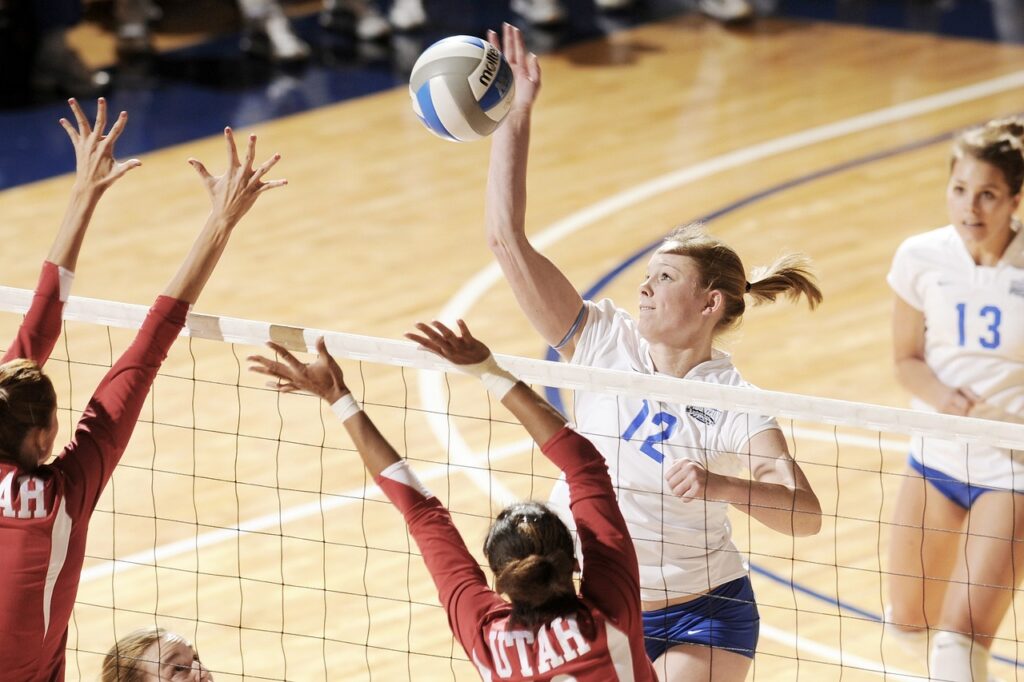
Mastering the Fundamentals
Perfect Your Passing Technique
- Importance of outside hitter passing for the team: Consistent passing takes pressure off the libero and keeps your team’s offense running smoothly.
- Body positioning and form: Master proper passing stance, with knees bent, a forward lean, and a solid platform created by your forearms.
- Platform control in different situations: Practice handling various passes – digs, serves, and free balls – to ensure you’re ready for any ball that comes your way.
Footwork is Key
- Mastering approach patterns: Learn the variations of the approach (four-step, three-step) to attack from different positions and at different tempos.
- Timing and adjustments to the set: Develop the skill to time your approach perfectly with the set and make in-the-moment adjustments based on the set’s location.
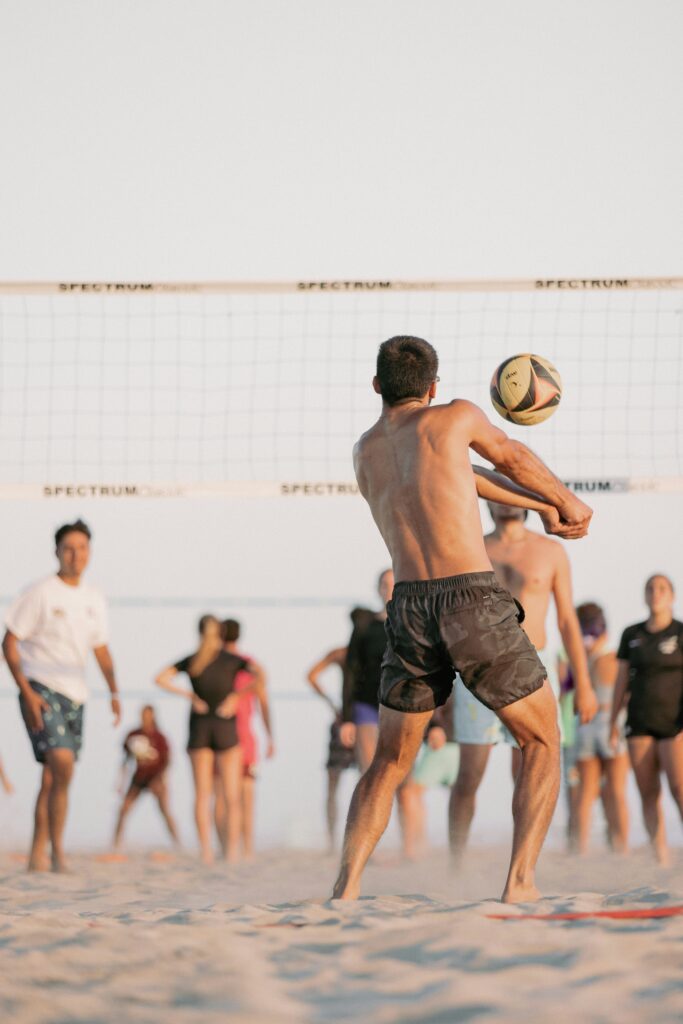
The Definitive Guide to Hitting a Volleyball with Perfect Footwork
Mastering the art of hitting a volleyball involves a powerful combination of technique, timing, and athleticism. At the core of a devastating spike lies the foundation of proper footwork. Let’s break down the steps to help you elevate your hitting game:
Learn the 4-Step Approach
- Memorize the Pattern: The standard approach consists of four steps: left-right-left-right (for right-handed hitters). This sequence creates rhythm and momentum, leading to a powerful jump.
- Practice Makes Perfect: Start by practicing the footwork without a ball, focusing on consistency and muscle memory. You can practice this anywhere!
- Distance and Length: The approach should begin behind the 3-meter line (10-foot line). Taller players might need to start even further back. Experiment to find what works best for your height and stride length.
Coordination with a Setter
- Set Up for Success: Have someone set or toss the ball to you. Initially, focus on catching the ball at the peak of your jump with both hands. This helps you sync your timing with the set and develop spatial awareness.
- Adjustments: Be prepared to adjust your approach based on the set’s height and location. This is where repetition and practice become crucial.
Independent Arm Swing Practice
- Wall Drills: While practicing footwork, also work on your arm swing independently. Use a ball and practice hitting against a wall. Focus on wrist snap, aiming for a consistent hitting point slightly in front of you at the right height.
Putting It All Together – Spiking with Technique
- Prioritize Form: When you start spiking, emphasize technique over power. Get the footwork, jump, and arm swing right before focusing on hitting the ball hard.
- Start Slow: Begin with slower sets and gradually increase the speed and difficulty as you gain confidence and consistency.
Practice, Practice, Practice
- Repetition is Key: Consistent practice is the most effective way to improve your hitting. Practice your footwork, coordination, and arm swing regularly. Seek feedback from coaches or experienced players to refine your technique.
Remember
- Focus on the Fundamentals: A solid foundation in footwork is essential for becoming a powerful hitter.
- Be Patient: It takes time and dedication to master the skill of spiking a volleyball.
By following this guide and committing to regular practice, you’ll be well on your way to unleashing thunderous spikes on the volleyball court.
Dominating the Attack
Once you have a strong foundation in passing and footwork, it’s time to focus on the core of the outside hitter’s role: unleashing powerful and strategic attacks.
Hitting with Power and Precision
- Arm swing mechanics: Develop a fluid, powerful arm swing with a high contact point. Focus on a full arm extension and snapping the ball on contact.
- Wrist snap for increased power: Learn to incorporate a quick wrist snap at the end of your swing. This adds topspin and makes your attacks harder to defend.
- Targeting lines and open areas of the court: Don’t just hit hard; hit smart. Learn to aim your shots down the line or cross-court, exploiting gaps in the opposing defense.

Expanding Your Toolbox: Advanced Shots
- Variety of shots (line, cross-court, roll shot): Master a variety of attacks to keep defenses guessing. Line and cross-court shots are your bread and butter, while roll shots change the pace, catching defenders off guard.
- Reading the blockers and making in-game adjustments: Observe the opposing block before you attack. Adjust your shots based on their positioning and timing.
- Utilizing tips, off-speed hits, and tooling the block: Clever tips, unexpected off-speed attacks, and using the block to your advantage add unpredictability to your offense, making you even harder to stop.

Develop a Strategic Serve
- Importance of a consistent serve: A strong serve puts pressure on the opponent’s reception, potentially disrupting their offense and directly earning you points.
- Types of serves (jump float, topspin, jump topspin – if aiming for a higher level): Learn basic serves like a float serve to start. As you advance, adding topspin and jump serves can make you even more dangerous.
- Targeting specific zones: Don’t just serve the ball over – have a plan. Target specific locations on the court to isolate players or disrupt their formations.
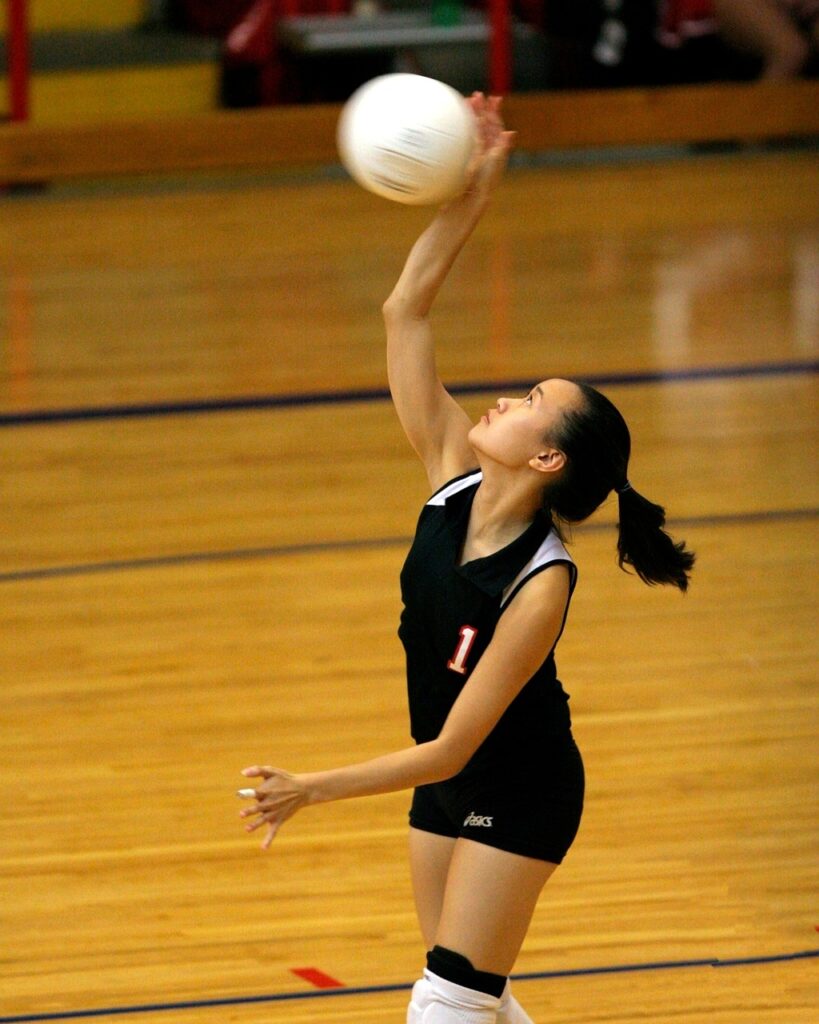
Sharpening Your Volleyball IQ
Being an unstoppable outside hitter isn’t just about physical skills. Developing a high volleyball IQ will set you apart and take your game to the next level.
Defense and Court Awareness
- Positioning for digs and transitions: Know your defensive responsibilities and where to position yourself for digs. Anticipate where the ball might be going and quickly transition from defense to offense.
- Anticipating opponent attacks: Study opposing hitters’ tendencies. Observe their approach patterns and body cues to anticipate where they might hit the ball.
- Reading the setter: Pay attention to the opponent’s setter. Their subtle cues often reveal where they intend to set the ball, giving you a head start on defense.
Understanding Offensive Systems
- Setter tendencies and preferences: Does your setter favor certain sets or prefer specific hitters in particular situations? Understanding their patterns will help you anticipate where you need to be for an attack.
- Timing your attack with complex plays: Complex offensive plays involve multiple hitters and timing is everything. Learn to recognize your team’s offensive signals and time your approach accordingly.
Communication is Crucial
- Calling for sets effectively: Clearly communicate your intentions to your setter. Use established calls to indicate where you want the set.
- Providing feedback to teammates: Be a vocal leader on the court. Share your observations of defensive alignments and opponent tendencies with your teammates.
Defense Secret Weapon: The Split Step
The split step, a fundamental movement used in many sports, is particularly crucial for outside hitters in volleyball. It’s a dynamic technique that allows for explosive movement and quicker reactions, making the libero a defensive powerhouse.
What is the Split Step?
The split step is a preparatory movement that pre-loads your muscles for explosive action in any direction. Here’s how it works:
- Preparation: As the opponent prepares to serve or attack, adopt a balanced athletic stance with knees slightly bent.
- Push-Off and Split: Just before the opponent makes contact with the ball (serve or spike), push off the ground with both feet simultaneously.
- Landing: The feet land slightly apart, with one foot slightly forward, creating a split stance. The body weight remains slightly forward, ready for quick movement in any direction.
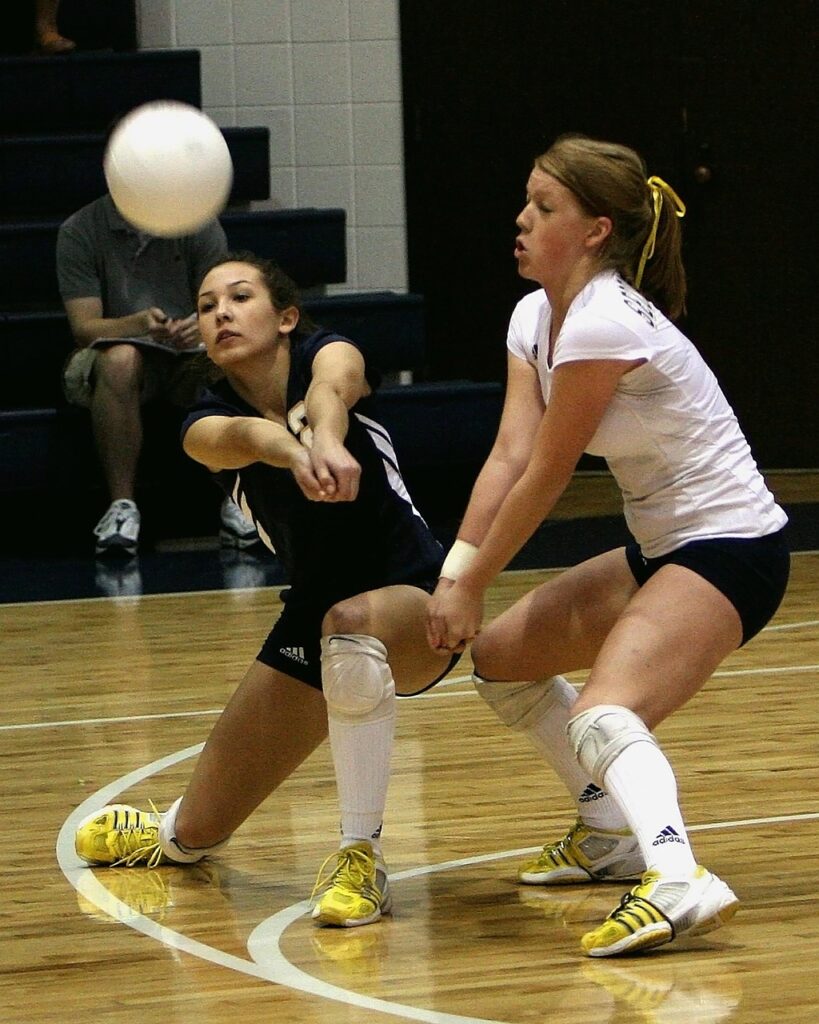
Playing Libero as a Training Tool for Outside Hitters
While playing libero may not be a long-term goal for outside hitters, there are significant benefits to occasionally taking on this role during practice or recreational games. Here’s why:
Improved Defensive Skills
Playing libero forces players to focus solely on defensive techniques, such as digging, receiving serves, and covering the back row. This dedicated focus enhances overall defensive skills and makes players more valuable in any position.
Increased Agility and Reaction Time
Liberos need to be agile and have quick reaction times to effectively cover a wide area of the back row. Training as a libero can develop these attributes, which are essential for all players, regardless of their position.
Understanding Team Dynamics
Playing libero provides insight into the role’s importance in team defense. It fosters a better understanding of how the libero interacts with other players and contributes to the team’s overall success.
Preventing Burnout
Switching positions and playing libero can break the monotony of repetitive drills and provide a refreshing change. It can rekindle enthusiasm and prevent burnout, keeping players motivated and engaged.
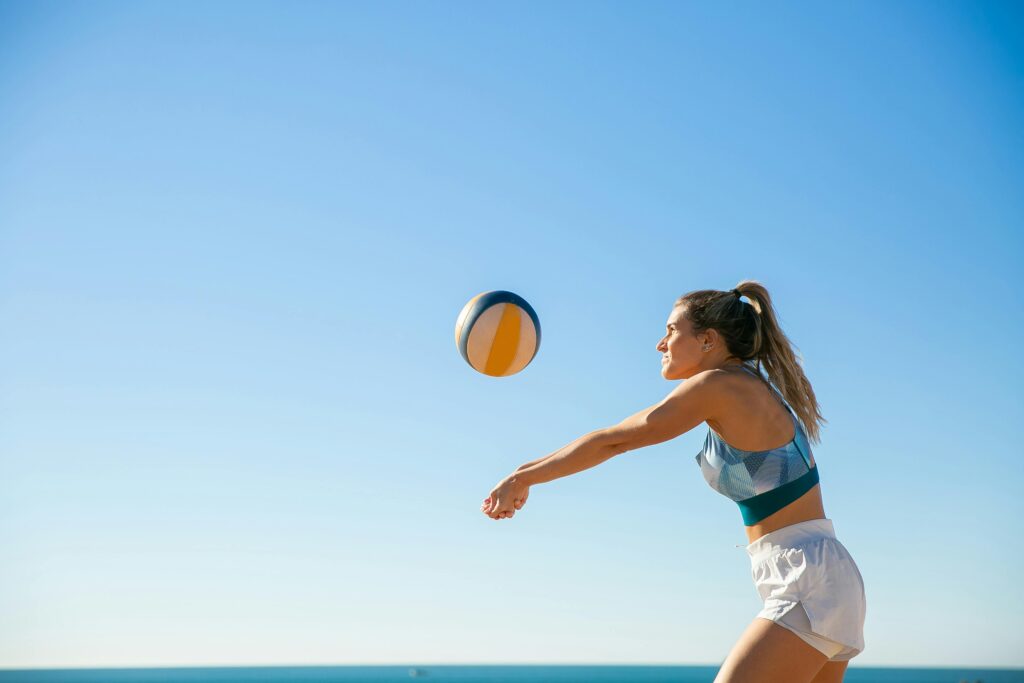
Incorporating libero training into your volleyball routine can be a valuable way to improve your defensive skills, enhance agility, and gain a deeper understanding of team dynamics. Even if you don’t aspire to become a full-time libero, playing this position can have a positive impact on your overall volleyball development.
Blocking for Outside Hitters: A Specialized Guide
As an outside hitter, you’re not just a primary attacker but also a crucial part of the defensive front. Your blocking skills can significantly impact your team’s success by shutting down the opponent’s outside hitters and disrupting their offensive rhythm.
Unique Challenges for Outside Hitters
- Dual Role: Balancing your offensive responsibilities with effective blocking can be demanding.
- Quick Transitions: You often need to transition quickly from attacking to blocking positions.
- Wide Range of Attacks: Outside hitters face a variety of attacks, requiring adaptability in blocking.
Specific Blocking Techniques for Outside Hitters
Reading the Hitter
- Focus on the Approach: Pay close attention to the opposing hitter’s approach angle and footwork.
- Watch the Arm Swing: Observe the hitter’s arm swing and wrist snap to anticipate the direction and speed of the attack.
- Anticipate Cross-Court or Line Hits: Be prepared for both cross-court and line attacks, as outside hitters often use both.
Positioning
- Start Inside: Typically, start your blocking position slightly inside the sideline to cover the line attack.
- Adjust for Cross-Court: If you anticipate a cross-court attack, quickly shuffle laterally to close the angle.
- Seal the Line: Ensure there’s no gap between you and the sideline to prevent easy line shots.
Timing
- Late Jump: As an outside hitter, you often have a shorter distance to cover for blocking, so a slightly later jump can be effective.
- Explode Upward: Once you’ve read the hitter, jump explosively with full arm extension to create a solid block.
Additional Tips for Outside Hitters
- Communication with Middle Blocker: Coordinate your blocking efforts with the middle blocker to create a strong double block.
- Practice Transitioning: Work on smoothly transitioning from attacking to blocking positions during drills and scrimmages.
- Develop Versatility: Learn to block different types of attacks, including tips, rolls, and hard-driven spikes.
Strategies for Specific Situations
- Against Strong Hitters: Prioritize sealing the line and angling your block to deflect the ball back onto their side.
- Against Weaker Hitters: Consider a more aggressive block, aiming to score a point or force a difficult dig.
By mastering these specialized blocking techniques, you’ll become a more valuable asset to your team, both offensively and defensively. Remember, blocking is a skill that requires continuous practice and refinement, so keep working on your technique and don’t be afraid to experiment with different strategies to find what works best for you.
The Perspective of a Setter: A Valuable Learning Experience
As a volleyball player, it can be incredibly beneficial to try playing as a setter from time to time. Here’s why:
Understanding the Setter’s Role
Stepping into the setter’s shoes helps you comprehend the demands and responsibilities of this crucial position. You’ll gain a deeper appreciation for the setter’s role in organizing the team’s offense, setting up attacks, and facilitating teamwork.
Improved Communication
Playing as a setter enhances your communication skills. You’ll learn to effectively communicate with your teammates, calling for the ball, indicating desired sets, and adjusting to different situations on the court.
Appreciation for Good Receives
Playing as a setter also makes you realize the significance of good receives. When teammates deliver accurate and consistent passes, the setter’s job becomes much easier, allowing them to focus on setting up effective attacks. On the other hand, poor receives force the setter to run after every ball, making it challenging to organize the offense and leading to disjointed play.
Developing Versatility
Learning to play as a setter makes you a more versatile player. You’ll develop a wider range of skills, including setting, digging, and blocking, which can be valuable in any position.
Building Empathy
Putting yourself in the setter’s shoes fosters empathy and understanding. You’ll gain a newfound appreciation for the challenges setters face and the importance of providing them with support and communication.
Enhanced Game Awareness
As a setter, you have a unique vantage point, overseeing the entire court. This perspective improves your game awareness, allowing you to anticipate plays, read the defense, and make informed decisions.
By playing as a setter occasionally, you’ll not only improve your volleyball skills but also develop a deeper understanding of the game and your teammates. It’s an enriching experience that can make you a more well-rounded player.
Training for Excellence
Natural talent only goes so far – dedication to training is what separates the best outside hitters from the rest. Focus on these key areas:
Strength and Conditioning
- Plyometrics for jumping power: Explosive exercises like box jumps, squat jumps, and depth jumps will enhance your vertical leap, making your attacks even more potent.
- Core training for stability: A strong core is essential for a powerful swing and proper jumping mechanics. Include exercises like planks, Russian twists, and rotational exercises.
- Injury prevention exercises: Volleyball places stress on your joints. Incorporate exercises focusing on flexibility, mobility, and strengthening your rotator cuff to help prevent injuries.
Skill-Specific Drills
- Attacking variations against blockers: Practice hitting against a blocker or blocking machine. Focus on different shot selections, tool shots, and adjusting to varied block positions.
- Serve-receive and defensive repetitions: Dedicate time to improving your serve receive and digging skills – the foundation of your team’s offense.
- Simulated game scenarios: Participate in drills and scrimmages that mimic game-like pressure and decision-making. This helps you apply your skills in realistic situations.
Visualization and Mental Training
- Building confidence: Visualize yourself making successful plays. This positive mental imagery translates to confidence on the court.
- Game-day preparation and focus: Develop pre-game routines and mental techniques to manage nerves and maintain focus during a match.
Improving Beyond the Court
Excellence in volleyball extends beyond the hours you spend on the court. Taking care of your body, analyzing your performance, and seeking additional guidance are essential for maximizing your potential.
Nutrition and Recovery
- Fueling your body for performance: Eat a balanced diet with plenty of whole foods, protein, and complex carbohydrates to provide your body with the energy it needs for training and competing.
- Rest and recovery strategies: Adequate sleep and recovery techniques like foam rolling, stretching, and active recovery are crucial for injury prevention and optimizing your performance.

Film Study and Analysis
- Breaking down your own mechanics: Record yourself during practice and games. Analyze your hitting technique, footwork, and overall court movement to identify areas for improvement.
- Analyzing opponents’ tendencies: Study video footage of upcoming opponents. Look for patterns in their attacks, defensive formations, and any weaknesses you can exploit.
Find a Mentor or Coach
- Benefits of outside expertise and guidance: A knowledgeable coach or mentor can provide personalized feedback, push you beyond your limits, and offer insights that you might not see on your own.
Learn from your coach and teammates!
- Don’t be afraid to seek advice and guidance from your coaches and more experienced teammates. They have been through it all and have much knowledge and experience to share. Ask specific questions about techniques, strategies, and game situations. They’ll be more than happy to help you improve your skills and become a better player.
- Remember, volleyball is a team sport, and everyone has something to contribute. Listening to your coaches and teammates will help you gain valuable insights and grow as a player.
Dedication is Key
Becoming an unstoppable outside hitter takes hard work and unwavering determination. Embrace the challenges, put in the hours on and off the court, and never stop striving for improvement. With dedication and passion, you can unleash your full potential and dominate as a powerhouse on the volleyball court.